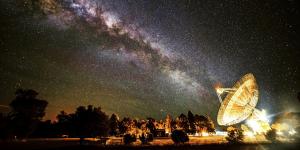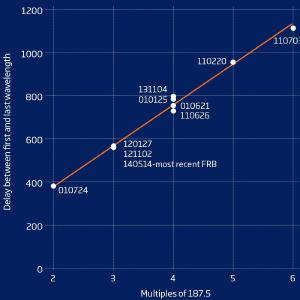Blog
Messages From Home
2 April 2015
 Wayne England
Wayne EnglandThere’s something strange about fast radio bursts, but they are not a message from aliens.
A fast radio burst (FRB) is a short, intense pulse of radio energy that have all the hallmarks of being astronomical in origin. Initially they were only detected at the Parkes radio telescope in Australia, which would make some kind of terrestrial origin likely. Later an FRB was detected at the Arecibo observatory in Puerto Rico, which made in more likely to originate from space. Earlier this year an FRB was detected in real time by multiple telescopes across the globe, which pretty much confirmed the origin as beyond Earth.
 Hippke, et al
Hippke, et alOne of the hallmarks of their astronomical origin their spectrum is dispersed. That is, instead of being a simple burst with all different frequencies happening at once, the frequencies were spread out, with higher frequencies first and lower ones later. This whistler effect is characteristic of a pulse that has traveled through the interstellar medium. It occurs because when an electromagnetic pulse interacts with charged ions, different frequencies are slowed by different amounts, with the lower frequencies slowed down more. So you get a dispersion effect. Stray bursts or chirps from terrestrial sources generally don’t have the same dispersion because they don’t travel through plasma and they don’t travel far. The time between the arrival of the high and low frequencies can be used to calculate the dispersion measure. Since the greater the dispersion measure, the more gas and dust the signal has travelled through, it is a good way to estimate the distance of the source.
This is where FRBs start to get really weird.1 It turns out the dispersion measure of these fast radio bursts seem to occur in multiples of 187.5 pc/cm3. Since the dispersion measures put the distances to these FRBs as billions of light years away, that would imply that their distances are evenly spaced across the universe, which isn’t likely for a natural phenomenon. A more likely solution is that they are much closer and originate within the Milky Way. The dispersion we observe would then be due to some unknown process rather than interstellar medium. This new process would need to have some mechanism to account for the discrete dispersions. That by itself would be extremely interesting, since it would demonstrate that dispersion can occur at the source as well as through interstellar interactions.
There is another aspect of these FRBs that’s interesting, and would imply an even closer origin. It turns out that their timing is very suspicious. They always occur within a tenth of a second of an official integer second in UTC (coordinated universal time). That’s really suspicious for something supposedly interstellar in origin, and would point toward something like stray signals from mobile phone towers and the like. Were I a betting man, I’d place my money on the terrestrial horse.
It should be emphasized that while this is interesting, it is an analysis of only 11 data points. We’ve only detected a handful of FRBs, and until we detect many more any speculation on patterns and origins should be made cautiously. Unfortunately most of the headlines want to spin the idea that since they appear both cosmic in origin and discretely spaced FRBs could be caused by some extraterrestrial intelligence. But going directly from “we don’t know” to “therefore aliens” is the realm of science fiction and hack journalism, not science.
Hippke, Michael, Wilfried F. Domainko, and John G. Learned. “Discrete steps in dispersion measures of Fast Radio Bursts.” arXiv preprint arXiv:1503.05245 (2015). ↩︎